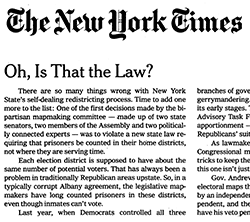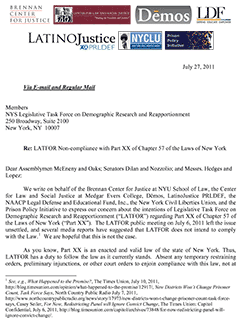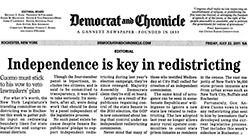The New York Times published a great editorial denouncing LATFOR's intention to ignore New York's law ending prison-based gerrymandering.
by Leah Sakala,
July 29, 2011
 The New York Times published a compelling editorial on Friday denouncing the Legislative Task Force on Demographic Research and Reapportionment (LATFOR)’s intention to blatantly ignore the enacted New York law that ended prison-based gerrymandering last year.
The New York Times published a compelling editorial on Friday denouncing the Legislative Task Force on Demographic Research and Reapportionment (LATFOR)’s intention to blatantly ignore the enacted New York law that ended prison-based gerrymandering last year.
The editorial declares:
Last year, when Democrats controlled all three branches of government, they passed a law to end prison gerrymandering. Republicans sued, but the case is still in its early stages. The redistricting panel — the Legislative Advisory Task Force on Demographic Research and Reapportionment — has decided to ignore the law while the Republicans’ suit goes forward.
As lawmakers draw their districts, and New York’s Congressional maps, they have access to a large bag of tricks to keep themselves and their favorites in power. But this one isn’t just shameless. It’s flat-out illegal.
Brenda Wright of Demos and Peter Wagner of PPI will be at the NCSL Summit in TX on Aug 9-10, and are available to meet about avoiding prison-based gerrymandering.
by Peter Wagner,
July 28, 2011
Brenda Wright of Demos and I will be attending the National Conference of State Legislatures Summit in San Antonio, Texas on August 9-10, 2011. If you will be there, too, and you want to set up a time to talk with us about how your state or local government can avoid prison-based gerrymandering, please don’t hesitate to contact us. We’re looking forward to meeting you!
PPI and six other civil rights advocacy organizations submitted letter to LATFOR demanding that it comply with NY anti-gerrymandering law.
by Leah Sakala,
July 27, 2011
The Prison Policy Initiative and six other civil rights advocacy organizations have just submitted a joint letter to the New York Legislative Task Force on Demographic Research and Reapportionment (LATFOR) demanding that it comply with New York’s 2010 law (Part XX) that ended prison-based gerrymandering. Earlier this month LATFOR announced that it plans to simply ignore the law due to a current lawsuit seeking to revert to the old method of unfairly counting incarcerated people where they are imprisoned.

The letter states:
Failure to comply promptly with the law’s requirement that incarcerated persons be reallocated for purposes of redistricting would be a serious violation of legal obligations. It would also gravely infringe upon the voting rights of New York’s citizens for which you could be held accountable.
We understand LATFOR has already received from DOCCS the information needed to make the reallocation required by Part XX and redraw the district lines accordingly. We respectfully insist you to do so immediately.
The New York Daily News has already covered this latest development in the fight to keep prison-based gerrymandering out of New York.
The letter was signed by seven civil rights organizations: Brennan Center for Justice at NYU School of Law, the Center for Law and Social Justice at Medgar Evers College, Dēmos, LatinoJustice PRLDEF, the NAACP Legal Defense and Educational Fund, Inc., the New York Civil Liberties Union, and the Prison Policy Initiative.
Imperial County Board of Supervisors votes 5-0 to reject prison-based gerrymandering and draw five genuinely equal districts.
by Leah Sakala,
July 27, 2011
The Board of Supervisors in Imperial County, California, is ensuring that all votes cast in its supervisor districts will carry equal political clout when the redistricting process is over.
Back in May, the Board voted 5-0 to exclude the approximately 8,400 people incarcerated in Calipatria and Centinela State Prisons for redistricting purposes.
Yesterday’s news brief from KXO Radio explains that the issue was a no-brainer:
Robert Moreno chaired the [Redistricting Advisory Committee]. He had presented the Supervisors with 3 possible maps. One included the prison population in the County. The Supervisors followed the lead of most other counties in the state, and rejected that map. They said the residents at the two state prisons were not voting members of the public, and most were not permanent residents of the county.
The Board is still deciding between preliminary districting plans, but they’ll make their final decisions with the assurance that each option is safe from of the nefarious practice of prison-based gerrymandering.
Rochester Democrat and Chronicle editorial criticizes Little v. LATFOR plaintiffs for trying to bring prison-based gerrymandering back to NY.
by Leah Sakala,
July 22, 2011
 The Rochester Democrat and Chronicle published an editorial criticizing the plaintiffs in the Little v. LATFOR lawsuit for trying overturn last year’s enacted law and bring prison-based gerrymandering back to New York.
The Rochester Democrat and Chronicle published an editorial criticizing the plaintiffs in the Little v. LATFOR lawsuit for trying overturn last year’s enacted law and bring prison-based gerrymandering back to New York.
The editorial denounces some New York legislators’ rejection of the law, proclaiming:
[A]rrogance also can be seen in Senate Republicans’ insistence on ignoring a new state law related to redistricting. The law adopted last year no longer allows many rural upstate communities to count state prison inmates as residents in the census. The vast majority of New York’s 56,000 state prison inmates are from urban areas such as New York City, Rochester and Buffalo.
I have to wonder which is worse: Trying to overturn one of the major civil rights victories of the decade, or proceeding as if the law had never been passed in the first place.
Joan Mandle of Democracy Matters and Citizen Action New York testified at LATFOR hearing, urged LATFOR to comply with anti-gerrymandering law.
by Leah Sakala,
July 22, 2011
The New York Legislative Task Force on Demographic Research and Reapportionment (LATFOR) has announced that it plans to ignore enacted New York legislation that mandates that incarcerated populations be counted at their home addresses for redistricting purposes. Unsurprisingly, many New Yorkers are unhappy about LATFOR’s refusal to comply with the law, which aims to secure equal representation throughout the state.

North Country Public Radio reported that Joan Mandle, Executive Director of Democracy Matters and Member of Citizen Action New York, testified at a recent public hearing. In her testimony she cautioned, “If we fail to enforce the law and fully implement the legislatures courageous decision, I am concerned that our state will be a laughing stock.”
YNN also covered the hearing and released a video that included a clip of Ms. Mandle’s testimony. She warned LATFOR of the consequences of disregarding the law: “Unless we count incarcerated persons in their home communities, we deny our own citizens fair and equal representation.”
Ms. Mandle shared with us her full written testimony.
New districts in Wisconsin to set new records for prison-based gerrymandering.
by Peter Wagner,
July 18, 2011
The Wisconsin legislature is rushing through a redistricting plan so they can lock in the maps before the scheduled recall elections can change who has the power to draw district lines. In that rush, prison-based gerrymandering is poised to have an even greater impact on state, county and municipal districts than it did a decade ago.
The Census Bureau counts Wisconsin prisoners as if they were residents of the communities where they are incarcerated, even though they can’t vote and remain legal residents of the places they lived prior to incarceration. Crediting thousands of people to other communities has staggering implications for Wisconsin’s democracy, which uses the Census to apportion political power on the basis of equally-sized state and county legislative districts.
Wisconsin’s 53rd Assembly district has the highest concentration of prisons in the state. The 53rd District claims 5,583 incarcerated people as residents of the district, even though state law says that incarcerated people remain residents of their homes. All districts send some people to prison, although some districts send more than others. But not all districts have prisons, and concentrating 23,000 prisoners in a handful of districts enhances the weight of a vote cast in those districts and dilutes all votes cast elsewhere.
In Wisconsin, this impact is largest in District 53, where without using prison populations as padding, the district would be 10% below the required size. This gives every 90 residents of the 53rd district the same influence as 100 residents of any other district in the state.
If that seems insignificant, consider that the Supreme Court allows districts to have populations that are 5% too large or small if the state can protect some other legitimate state interest by doing so. The federal judges who have for decades drawn Wisconsin’s state legislative districts have had an even higher standard, allowing only a 1% deviation from strict population equality. The Republican majority of the legislature which drew the new districts took an even higher standard in the Assembly, drawing districts that are, by Census counts, no more than 0.4% too large or small.
Continue reading →
Prison Policy Initiative and Demos submit testimony and solutions to California's Citizens Redistricting Commission's prison-based gerrymandering problems.
by Aleks Kajstura,
July 18, 2011
Friday, the Prison Policy Initiative and Dēmos presented testimony to the California Citizens Redistricting Commission (CRC) discussing prison-based gerrymandering and making recommendations on how the Citizens Redistricting
Commission (CRC) can take steps to minimize the impact of prison-based gerrymandering in drawing state legislative districts for California.
In past redistricting cycles, California chose to prioritize population equality so highly that it drew all legislative districts exactly the same size, rather than permitting a small population deviation among legislative districts as most states do. Ironically, without a fix to prison-based gerrymandering, California’s devotion to population equality in redistricting was futile. This problem is illustrated by a cluster of districts drawn after the 2000 Census in the Central Valley: 8.6% of the 30th Assembly district was incarcerated in state prisons, 5.7% of the 20th Congressional district was incarcerated in state prisons, and 4.3% of the 16th Senate district was incarcerated in state prisons. In each of these districts, every group of 91 to 94 people were given as much influence in Sacramento as 100 people from any other district that was not itself padded with large prison populations.
The testimony contains more examples with detailed solutions that are still implementable, even at this late stage of redistricting.
The files mentioned in the testimony can be downloaded here:
So you want to get elected with minimal effort? New video shows that your best bet is to run for office in a prison-gerrymandered district.
by Leah Sakala,
July 14, 2011
So you want to get elected with minimal effort? Your best bet may be to run for office in a district with very few actual residents, says a new video by Bruce Reilly, of Direct Action for Rights and Equality.
How? Move to a district with a large prison, make sure the local government counts incarcerated people as residents, campaign to win the support of the handful of actual residents, and voila! You’re in, thanks to prison-based gerrymandering.
Here’s how it works:
The Boston Workers Alliance has released a resolution to end prison-based gerrymandering in Massachusetts.
by Leah Sakala,
July 14, 2011
The movement to demand fair redistricting in Massachusetts is growing fast.
The Boston Workers Alliance has released a resolution with both short- and long-term plans to end prison-based gerrymandering in Massachusetts.
Using the video we recently released on how to avoid prison-based gerrymandering in Massachusetts, the Boston Workers Alliance calls on the Massachusetts Legislature to use the allowable 5% deviation from the ideal district size to compensate for the distortion caused by prison-based gerrymandering. They further resolve that there be legislative amendment that ends prison-based gerrymandering in the state by the 2020 Census, and urge the Census Bureau to count incarcerated populations at home in the first place.
They conclude:
That the socio-political, economic and existential implications and consequences of prison-based [gerrymandering] on the inmates’ family, community and the larger society regarding public safety, human dignity and human flourishing should fundamentally inform this process of ending prison-based gerrymandering in Massachusetts since it negates the pristine democratic principles of the American Constitution and the democratic process, thus necessitating an end to prison-based gerrymandering in Massachusetts as the states of New York, Maryland and Delaware have enacted.
Our hats go off to the Boston Workers Alliance for their leadership in the movement to end prison-based gerrymandering in Massachusetts.
 The New York Times published a compelling editorial on Friday denouncing the Legislative Task Force on Demographic Research and Reapportionment (LATFOR)’s intention to blatantly ignore the enacted New York law that ended prison-based gerrymandering last year.
The New York Times published a compelling editorial on Friday denouncing the Legislative Task Force on Demographic Research and Reapportionment (LATFOR)’s intention to blatantly ignore the enacted New York law that ended prison-based gerrymandering last year.





